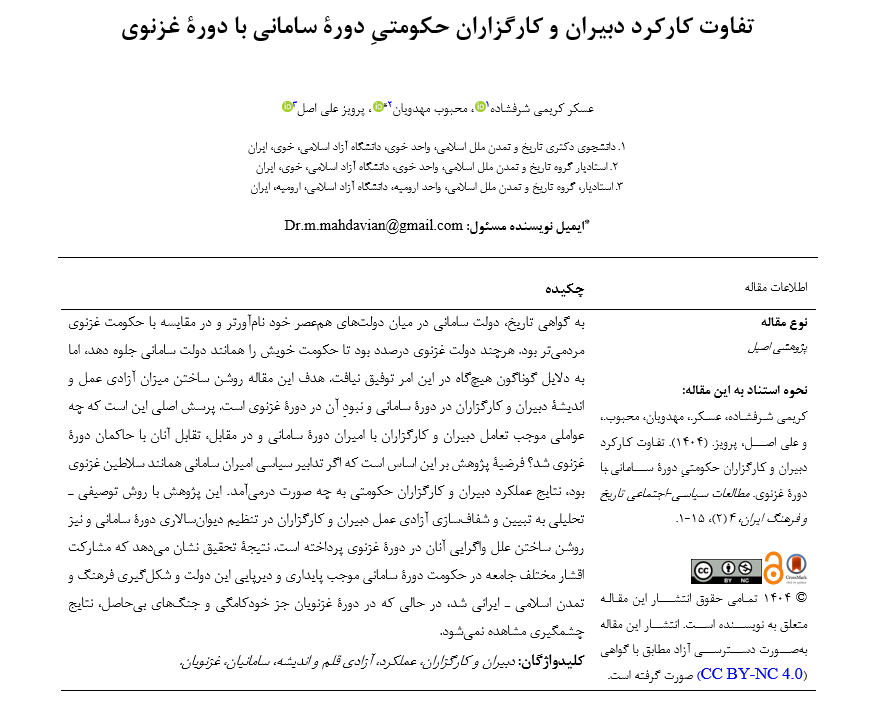Differences in the Roles of Secretaries and Government Officials in the Samanid and Ghaznavid Periods
Keywords:
Secretaries and agents, performance, freedom of writing and thought, Samanids, GhaznavidsAbstract
According to historical evidence, the Samanid dynasty, among its contemporary states, was more renowned and considerably more popular among the people compared to the Ghaznavid rule. Although the Ghaznavid rulers attempted to portray their government as a continuation of the Samanid system, they never succeeded due to various political and social factors. The purpose of this study is to elucidate the degree of freedom of action and thought enjoyed by secretaries and administrative officials during the Samanid period, and the absence of such freedom during the Ghaznavid era. The central research question is: what factors led to the cooperation of secretaries and officials with the rulers of the Samanid period, and to their conflict with the Ghaznavid sovereigns? The main hypothesis is that if the political strategies of the Samanid rulers had resembled those of the Ghaznavid sultans, the administrative performance of the secretaries and government officials would have yielded markedly different outcomes. This article, using a descriptive–analytical method, seeks to clarify the extent of professional and intellectual autonomy among secretaries and officials in structuring the bureaucracy of the Samanid state, as well as to illuminate the divergence and restriction of such autonomy during the Ghaznavid period. The findings indicate that the participation of various social classes in the governance of the Samanid era contributed to the stability and longevity of that dynasty and to the flourishing of the Islamic–Iranian civilization. In contrast, the Ghaznavid period was characterized predominantly by autocracy and fruitless wars, which failed to produce any enduring political or cultural achievements.
Downloads
References
Al-Biruni, A. R. M. i. A. (1984). Verifying All That the Indians Recite, Either Rational or Despicable. Institute for Cultural Studies and Research.
Anvari, H. (1994). Administrative Terminology in the Ghaznavid and Seljuk Periods. Tahouri Publications.
Bayhaqi, A.-F. M. i. H. (1996). Bayhaqi's History (also known as The Mas'udi History) (1st ed., Vol. 1). Hirmand Publications.
Bosworth, E. C. (1998). The History of Sistan: From the Rise of the Arabs to the Rise of the Saffarid State. Amir Kabir Publications.
Christensen, A. (1989). L'Iran sous les Sassanides (Iran under the Sasanians). Donyaye Ketab.
Frye, R. N. (2000). The Cambridge History of Iran, Vol. 4: The Period from the Arab Invasion to the Saljuqs (3rd ed.). Amir Kabir Publications.
Kassaei, N. (2004). A Culture of Educational Institutions in Iran (From Ancient Times to the Establishment of the Safavid State) (1st ed.). University of Tehran Press.
Khalili, K. (1952). The Ghaznavid Sultanate. Afghan Historical Society.
Krachkovskaya, I. Y. (2014). The History of Geographical Writings in the Islamic World (4th ed.). Scientific and Cultural Publications.
Narshakhi, A. B. M. i. J. (1972). The History of Bukhara. Iranian Culture Foundation.
Spuler, B. (1990). The History of Iran in the Early Islamic Centuries (1st ed., Vol. 2). Scientific and Cultural Publications.

Downloads
Published
Submitted
Revised
Accepted
Issue
Section
License
Copyright (c) 2025 Askar Karimi Sharafshadeh (Author); Mahboob Mahdavian (Corresponding Author); Parviz Ali Asl (Author)

This work is licensed under a Creative Commons Attribution-NonCommercial 4.0 International License.







